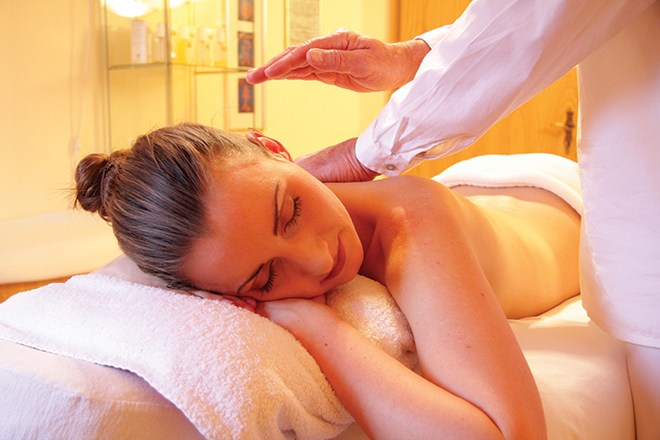Erika Dux (65), a doctor of medicine from the University of Düsseldorf and trained in a wide range of additional disciplines, such as Chinese-Japanese Bo-Meridian Shiatsu therapy, has been living in Portugal for 35 years and works privately as a doctor. She has three grown–up daughters.
Why do people become ill?
I’m afraid I really can’t answer that question for you.
What are the causes of illness?
For different reasons: people get an infection, have a genetic illness or a metabolic disorder, or are affected by exhaustion and intoxication caused by pollution, environmental degradation, or precarious housing.
How do you approach illness? What’s your treatment like?
There are three sides to it. Firstly: OBSERVING. I listen to what each individual says, or doesn’t say. I watch how my patients move, what they move, or don’t move, what moves them. Secondly: TOUCHING. Then I touch them. By touching them, my impression is either confirmed or modified, or takes shape as a diagnosis. I go to the centre, to the abdomen, check that against what I can feel in their pulse. I start to interact with what the person’s organs tell me. Finally I embark on an audible or inaudible DIALOGUE with the patient – or with the parts that the patient consists of.
Is that how you find out what’s wrong with the patient?
Yes, ideally. Using these factors, I try to understand the patient and to work out what the matter is, where they’re at, where they’re coming from, and maybe where they want to get to, what my contribution to this can be, what they actually want.

Then you devise a therapy that gets the patient back on track, that leads them back to good health?
No, I don’t devise anything. I try to empathise with what the patient may be feeling. Then I try to understand where the obstacle lies on the path to being free of pain, or to being healthier or less ill. The only people who know where they are heading are the patients themselves. In Chinese medicine, there are laws that are more than 2,000 years old, you can’t just turn these on their head. Therapeutic work is a constant engagement of patient and therapist in mutual agreement.
You look at the whole person, not just their parts…?
There are no parts, just the expressions of wholeness in different parts of the body, or their combination, the function, where the disorder manifests itself. It may also be the case that the disorder manifests itself quite differently from its origins. For example, someone can have a headache, and this pain can have a hundred different causes. Detecting it (this is very hard to explain) takes the form of a picture – like in a game played with dominoes where the patient keeps repeating the same pattern. There are one or more triggers and then the first tile starts to fall and the whole chain starts. Firstly, that happened, and then the patient said this, now I find this, and when that happens, then something else happens and so on, and they have a headache. There can be many triggers. I see my job as a doctor as being first of all to understand what I am faced with, what has happened and how these dominoes fall, when they fall and what a possible trigger could be. That is my task first of all, to discover this together with the patient. Ideally, the pictures that the patient has are the same as the ones I have. That is the ideal situation. In other words, the patient sees and recalls a scene in their memory, and I can see it too, and that is where we meet. Then I can see everything: ah, so that’s what’s happening. And that’s how it goes.
You talk a lot to your patients. What happens in this communication?
It’s a difficult decision finding out what patients want. What they really want and what they appear to want. And who am I to decide what they want at that precise moment? That is already the first major hurdle, because I can never know exactly what the patient wants. Never. I can always get it wrong. It can always be just a projection. I can always think: ah, look, it’s much better for them if they are healthy, if they act in this way. But in the end I can never say to patients, now you must do this or take this and that, because that’s just not possible. The decision must always come from the patient. It’s not even up to me to make an evaluation of that. Even if a patient decides “I want to die now,” in the end I have to accept that, even if don’t agree with them. That’s the way it is! When patients say that they need to play the domino game another hundred times, there’s no point in my repeating the message the same one hundred times: “oh, come on …” Unless I formulated it as an I-message. That I don’t think it’s good, but not in my role as a therapist or doctor. In the communication, it’s the patient that provides the direction. And my communication cannot be manipulative, otherwise I’ve done something wrong.
So someone comes to you with two crutches, like Lazarus, and asks for help. What do you do then?
Then I embark on exactly this process. I form a picture. I gain an impression. I get a resonance in myself, an echo, images. It’s similar to an idea, it just happens.
 An orthodox medical practitioner, let’s say an orthopaedist, looks at the patient’s foot using different images produced with the aid of technology: X-rays, CAT scans, ultrasound – the whole gamut. They can recognise a bone cyst, puzzle over cancer and other illnesses. Then they advise the patient to have an operation. Lazarus’ private health insurance pays because the public health system is already completely swamped with appointments for operations. Then you come along and say, maybe we don’t even need an operation. A bone cyst that is growing can also be made to shrink. What sort of an approach is that?
An orthodox medical practitioner, let’s say an orthopaedist, looks at the patient’s foot using different images produced with the aid of technology: X-rays, CAT scans, ultrasound – the whole gamut. They can recognise a bone cyst, puzzle over cancer and other illnesses. Then they advise the patient to have an operation. Lazarus’ private health insurance pays because the public health system is already completely swamped with appointments for operations. Then you come along and say, maybe we don’t even need an operation. A bone cyst that is growing can also be made to shrink. What sort of an approach is that?
Chinese medicine, which is where I come from, has a prophylactic character; in other words, in the Chinese tradition, doctors are always responsible for ensuring that patients do not fall ill. This is a completely different approach, of course. That is the doctor’s role. You have to work with the patient’s capacities. When I ask the patient with the foot problem what the matter is, I have to observe that situation, and we work on what that problem actually is. I also have to see what is missing and what is available for the patient with the foot condition, how this gap can be filled. That gap is a piece of information that is given to us; it has an effect because it is linked to another piece of information, one that has a special effect on patients: e.g. a belief in confidence. My work is about revealing capacities: like self-confidence, for example. In principle, everyone can cure a lot of things in themselves when the capacity for self-healing is revealed.
What can individuals do for themselves in order to activate their own powers of self-healing?
In order to answer that question, first of all you have to uncover these things in yourself: what do I need? What am I doing right and where am I creating problems for myself? What am I allowing myself to be hindered by at the moment, e.g. when walking? What is happening in my life? What could I change? What changes am I frightened of? What do I find difficult? These are all questions that I can either answer for myself or else I can look for someone who can answer them with me.
In your view, are the bodily symptoms of a physiological illness always combined with a poor state of mental or spiritual health?
There’s no separation between body, soul and mind. They’re always interconnected. No physical illness can be separated from one’s mental state. Things are always changing in life, and so there’s always something changing in my access to life, to my being.
So, should a doctor be less of a mechanic?
It’s always good to have a diagnosis that can be viewed objectively. The only question then is: what do I do with this knowledge? Do I despair about it? One of my first patients was in his early forties and he had a problem with his knee; he had a problem with his spinal column, and he had nothing but pain. We talked and I asked him what the matter was. He answered that everything was bad and nothing worked any more and he’d already been to lots of doctors and the last one had said to him, you’ve got about three more years and then you’ll be in a wheelchair. So, I said to the patient: Then I congratulate you. Then he said to me Excuse me? And I replied: Yes, it’s great, the Good Lord has apparently met you and has told you which way to go… Because apart from the Good Lord and yourself, nobody can know what will happen…
Then something clicked in him. I’ve now known the man for 25 years. In the meantime, he’s built two houses and goes horse riding…

Obviously without a wheelchair?
It’s difficult to go riding in a wheelchair. He still has problems occasionally and comes to my surgery sometimes when his neck gives him pain. This happens when he’s been working too much with his head. But he’s fine. It has less to do with me than with him. The information that he believed in has changed. He has changed the programme. If he had continued thinking that he would be sitting in a wheelchair within three years then he really would be in a wheelchair now. In the health system, it shouldn’t be the case that someone in a position of authority is allowed to impart supposed truths to people like this. You can, however, say that there’s nothing you can do, and I myself have patients who I refer to colleagues because I don’t know how to proceed any further. But you can’t say this is how it is and that next week it’ll be like that, and that if you don’t do this now you’re lost.
So, it’s more about promoting good health in a sick person than fighting disease?
I have to work with what patients have available to them. It could be certain characteristics, like hope for example; it could be discipline, their love of life, their longing for something. There can be many characteristics: anger too, feeling lost. I can work with all of that so that it fits into the disease process and brings about a change. And of course, everyone needs to feel that they can be agents of change. And that’s why I think it’s worth being a doctor and practising medicine.
Medication and drugs?
You don’t have to take them. But I also don’t see any sense in not using things if someone is in endless pain and there are chemical means available to alleviate that. If it has to be, it has to be. I am also not totally opposed to antibiotics, or to the use of cortisone. But you have to decide these things case by case.

What do you think of our health system?
Personally, I would advise many people to swap a night’s drinking for a weekly massage, or something that does them some good. People should free themselves from ignorance and from disrespecting their own bodies. People come to me and say it hurts so much here, it must be their liver. No, I say, unfortunately the liver is on the other side. And this is not just a one-off case. A better health system would start with people learning more about their own body, and that it is worth looking after it, in the same way we look after our teeth. This should start at school. The question must be asked “what does a human being feel like” and “what does one need to do to feel well.”
Many thanks for the interview.
ERIKA DUX
erikadux@gmail.com
 Eco123 Revista da Economia e Ecologia
Eco123 Revista da Economia e Ecologia


